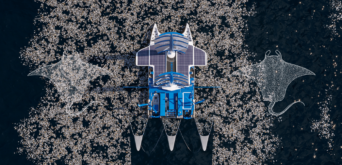Mutant plastic-eating bacteria: sci-fi or plan B against plastic pollution?
Plastic pollution
Science
17 June 2023

Plastic pollution is a trauma of unprecedented force and speed for living organisms.
Some bacteria seem to have evolved in just a few decades to adapt to this invasion. A challenge for science.

Mutant bacteria?
It all began in 2016, in a mud puddle behind a plastic bottle recycling plant in Osaka. Japanese researchers made a discovery that baffled the international scientific community: a new species of bacterium, Ideonella sakaiensis, capable of eating PET plastic thanks to its digestive enzymes.
This bacterium set off a veritable scientific stampede, with research teams from all over the world coming up with more and more revelations: plastic-eating bacteria at the top of the Alps, in swamps in China, in the Arctic…
Fast and furious: 400 species of fungi and bacteria have evolved
However, these advances quickly lead to some rather macabre conclusions: faced with the omnipresence of plastic pollution, certain bacteria have adapted to an environment degraded by our waste and mutated to produce new enzymes capable of digesting some of these plastics.
This mutation is brutal and extremely rapid: 60% of these plastic-digesting enzymes belong to no known class.
To date, over 400 species of plastic-eating fungi and bacteria have been identified worldwide. Their presence is proportional to the amount of plastic pollution around them.
Season 2 spoiler: no, these species aren’t going to put an end to plastic pollution by having a big all-you-can-eat buffet in the oceans. For these natural bacteria to be useful, they would have to be genetically modified to degrade plastic hundreds or thousands of times faster.
However, industrial research has taken up the subject and is exploring new ways of recycling plastic. In the laboratory, “super-enzymes” capable of breaking down plastic waste faster are being developed, as are genetically modified micro-organisms designed to break down polymer chains. This is enzymatic recycling.

Super-Enzymes: digesting plastic on an industrial scale
Today, when we speak of traditional (or mechanical) recycling, we often refer to “decycling”. This method involves crushing plastics to make flakes that will be melted down into a new object, making the material fragile and often necessitating the addition of virgin plastic to the final material.
With enzymatic recycling, by “digesting” polymers, once the plastic has been broken down by enzymes, it doesn’t disappear – it’s just broken down into smaller molecules, the basic monomers. These can then be reassembled to make a plastic of equivalent quality to the virgin plastic.
The first large-scale commercial applications still seem a long way off, but one of the world’s forerunners in enzymatic recycling, the French company Carbios, claims that enzymatic recycling is a forward-looking solution for the end-of-life of plastics.
“Above all, Carbios makes the difference when it comes to circularity. If you buy a bottle recycled using mechanical processes, it will be thrown away after a few reuses. With one tonne of plastic, we produce 97% plastic components. And we can achieve 30 to 50 cycles where conventional recycling is limited to three to five.”
Carbios claims that its approach generates a lower carbon footprint than virgin PET. The company calculates that it can save up to 46% in CO₂ emissions, compared with virgin PET plastic, taking into account its manufacture and incineration.

A breakthrough…to reinvent everything !
While it can be part of a more virtuous circular economy for plastics, enzymatic recycling is not the solution to our society’s addiction to single-use plastics.
Even before this recycling process becomes a concrete alternative to traditional recycling, the latter must overcome the obstacles to its industrial development.
On the one hand, enzymatic recycling today only concerns PET, a plastic that accounts for just 12% of the world’s plastic waste.
All other types of plastic are out. Gone, too, are the many different types of multi-material packaging: while a simple label can make a plastic bottle unsuitable for recycling, manufacturers need to make a real effort to market standardized, rationalized packaging to contribute to recycling efforts.
On the other hand, these approaches remain far more costly and energy-intensive than production from virgin plastic – a major barrier to its adoption by manufacturers. If the cost and economic benefits of enzymatic recycling are not competitive, then it will not be able to compete with conventional recycling.
Finally, all players agree on the main current obstacle to increasing recycling rates: practices for collecting, transporting and processing waste for recycling need to improve.
These are costly, labor-intensive operations, which encourage the export of waste to developing countries where labor costs are low but waste management infrastructures are less developed.
If mutant plastic-eating bacteria teach us that nature can be cynical when it comes to adaptation, the development of enzymatic recycling shows us that no “magic” solution alone can meet the challenge of plastic pollution.
40% of plastics produced are used only once before becoming waste, which we continue to struggle to manage. Reducing this pollution drastically requires the mobilization of all resources: both in a curative approach, of which recycling and collection at sea and on land are part, and in a preventive approach. The best waste is that which is not produced. The SeaCleaners is constantly working on both fronts, using concrete action as its answer to the twin pitfalls of scientism and resignation.
